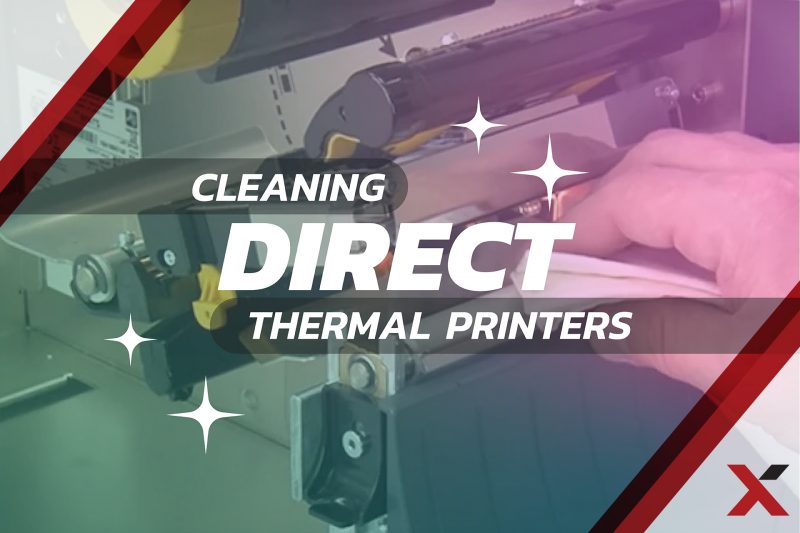Is your direct thermal printer acting out? It’s easy to blame the little thing. But the likely culprit is… not enough love. We often forget how delicate the components of these devices are. So the real questions are: Are your thermal printers getting routine cleanings? Routine maintenance?
Whether you’re using direct thermal printers for barcodes, shipping labels, internal labeling, or any routine printing, understanding how to clean, maintain, and troubleshoot these printers can prevent printer tantrums and keep your operation moving smoothly.
Cleaning Your Direct Thermal Printer
Regular Cleaning
Make cleaning a regular part of your maintenance routine to keep your direct thermal printer running smoothly. Dust, adhesive residue, and paper debris can affect print quality and lead to printer malfunctions. Here’s how to clean your printer effectively:
- Turn Off the Printer: Always ensure the printer is powered down and unplugged before starting any cleaning process.
- Open the Printer: Access the print head and other internal components by opening the printer. Consult your printer’s manual if you’re unsure how to do this.
- Clean the Print Head: The print head is the most crucial part of your printer. Use a cotton swab or a specialized thermal print head cleaning pen dipped in isopropyl alcohol to gently wipe the print head. This removes residue and prevents poor print quality. For convenience, pre-moistened cleaning wipes designed for thermal print heads can also be used.
- Clean the Rollers: The platen roller (the roller beneath the print head) can accumulate adhesive and debris, affecting paper feed and print quality. Use a lint-free cloth and isopropyl alcohol to clean the rollers. Make sure to inspect the roller for any cuts or damage that might require replacement.
- Remove Dust and Debris: Dust and particles can obstruct sensors and affect the printer’s performance. Use a can of compressed air to blow out dust from the interior components and sensors.
Handling Thermal Paper
Direct thermal printers use heat-sensitive paper that can be affected by environmental factors. Proper handling and storage of thermal paper can prevent issues:
- Store Paper Properly: Keep thermal paper in a cool, dry place away from direct sunlight to prevent degradation of the coating.
- Avoid Contaminants: Ensure that your hands are clean and dry when handling thermal paper. Oil, dirt, or moisture can affect print quality.
Routine Maintenance of Direct Thermal Printers
Regular Inspections
Routine checks can help catch issues before they become significant problems:
- Inspect the Print Head: Regularly check for signs of wear or damage on the print head. Replace it if you notice any issues affecting print quality.
- Check Paper Feed Mechanism: Ensure the paper feed path is free of obstructions. Check for any misalignments or wear that could affect paper movement.
- Monitor Print Quality: Keep an eye on the quality of the print output. Issues like faded prints or inconsistent printing can indicate maintenance needs.
Software and Firmware Updates
Keeping your printer’s software and firmware up to date ensures it operates with the latest improvements and bug fixes:
- Check for Updates: Regularly visit the manufacturer’s website or use the printer’s management software to check for updates. Follow the instructions provided to update the printer’s firmware.
- Adjust Settings: Sometimes, adjusting the print settings can resolve issues related to print quality or performance. Consult your printer’s manual for guidance on adjusting settings like print speed and darkness.
Troubleshooting Common Issues
Poor Print Quality
If you’re experiencing poor print quality, such as faded prints or missing areas, try the following:
- Clean the Print Head: Residue buildup can cause poor print quality. Clean the print head using the methods described above.
- Check Paper and Ribbon: Ensure you are using the correct type of thermal paper. If the paper or ribbon is outdated or incompatible, it can affect print quality.
- Adjust Print Settings: Increase the print darkness setting if the prints are too light. Adjust the print speed if necessary, as slower speeds can improve print quality.
Paper Jams
Paper jams can disrupt your printing process. Here’s how to resolve them:
- Clear the Jam: Open the printer and carefully remove any jammed paper. Check for any torn pieces that might still be stuck inside.
- Check Paper Path: Ensure that the paper is loaded correctly and that there are no obstructions in the paper path. Align the paper properly and ensure it is feeding correctly.
Printer Not Recognizing Paper
If your printer is not recognizing the paper, try these steps:
- Check Paper Type: Ensure that the paper you’re using is compatible with your printer. Consult the manufacturer’s recommendations for paper types.
- Inspect Sensors: Dust or residue on the paper sensors can cause recognition issues. Clean the sensors with a soft cloth and compressed air.
Print Head Errors
If you receive print head errors or notice inconsistent prints, address the issue as follows:
- Clean the Print Head: Residue or buildup on the print head can cause errors. Clean it thoroughly as described earlier.
- Check for Damage: Inspect the print head for any visible damage. If damaged, it may need to be replaced.
Final Tips
- Regular Maintenance: Establish a regular cleaning and maintenance schedule to keep your direct thermal printer in top condition.
- Proper Handling: Handle thermal paper and printer components with care to avoid issues.
- Consult the Manual: Always refer to your printer’s manual for specific instructions related to cleaning, maintenance, and troubleshooting.
We’re Happy To Help!
As the nation’s largest privately-held, brand-neutral managed print services provider, we have a large army of expert technicians ready to service your printing devices.
Reach out to us today for an assessment.
